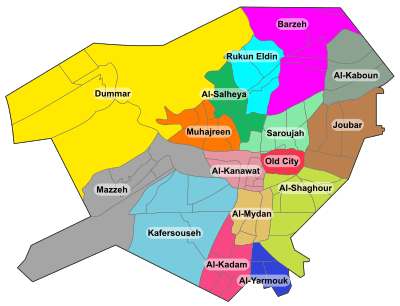Rukneddine
Rukneddine or Rukn al-Din (Arabic: ركن الدين) is a district of Damascus, Syria. In the 2004 census, it had a population of 92,646.[1] It is the historic Kurdish quarter of the city.[2]

History
Originally named after Rukn al-Din Mankuris al-Faliki al-Aadili (ركن الدين منكورس الفلكي العادلي) who was a servant and companion of Falik al-Din Suleiman al-Aadili (فلك الدين سليمان العادلي), a half brother of al-Aadil Seif al-Din Abu Bakr Bin Ayoub (العادل سيف الدين أبو بكر بن أيوب) who succeeded his other sibling Saladin in rule.[3]
The Municipality has the famous "al-Madrasa al-Rukniyeh" in Shamdine Square (named after Said Pasha Shamdine), where Rukn al-Din Mankuris was buried.[4]
it is the birthplace of renowned Islamic scholar and former Grand Mufti of Syria Sheikh Ahmed Kuftaro, who served at the Abu Nur Mosque in the district[5] and was buried there in 2004.
On 21 March 1986, Kurds seeking to celebrate the Kurdish-Iranian New Year (Newroz) clashed with state security forces intending to prevent any festivities from occurring. One Kurdish youth, who was visiting from the northeastern city of Qamishli, was killed by police.[6]
On 4 May 2015, during the Syrian Civil War, Jabhat al-Nusra fighters on motorcycle committed a suicide attack against security forces in the municipality.[7][8]
Syrian Civil War
On 12 August 2011, some months after protests had begun elsewhere in Syria, anti-government protests were held in several districts of Damascus, including the city's Rukneddin district. At least eight protesters had been shot dead by security forces during a demonstration with thousands attendees.[9] On 07.Sep. 2012 A motorcycle bomb in Shamdeen square era killed at least five members of the security forces. [10] On 04.08.2012 the so-called "the battalion of damascene martyrs" attacked and took 4 secret service cars and there weapons and one heavy DShK. On the very next day, a brutal fighting started between the opposition troop about 600 armed men, and the Arab Syrian army with help of security service and the police. It lasted 23 days and ended with the remaining opposition groups surrendering. the exact number of deaths is unknown due to the isolation and lack of media coverage. [11] Since the start of the first protest till this day, the district has been a place for the police raids by Syrian security forces and the so-called Shabiha claiming they are searching for armed groups and terrorists. About 50 to 100 young men were arrested or taken by force for military services under the law of "Syrian reserve army".
Districts
- Asad ad-Din (pop. 34,314)
- Ayyubiyah (pop. 13,089)
- Al-Fayhaa (pop. 11,330)
- Al-Naqshabandi (pop. 33,913)
Notable people
- Khalid Bakdash (1912–1995), the leader of the (SCP) Syrian Communist Party.
- Muhammad Said Ramadan al-Bouti (1929-2013), "Shaikh of the Levant" was one of the most ntoed Islamic scholar in the 20th-21st century.
- Khayr al-Din al-Zirikli (1893-1976), a Syrian historian, nationalist and poet
- Ahmed Kuftaro (1915-2004), was the Grand Mufti of Syria, the highest officially appointed Sunni Muslim representative of the Fatwa-Administration in the Syrian Ministry of Auqaf in Syria
- Mohammad Hosni (1894-1969) father of Soad Hosny(1943-2001) was a master calligrapher at the Royal Institute of Calligraphy in Cairo.
- Mohammed Amin Kuftaro(1877–1938), was a noted Islamic scholar and head of the Naqshbandi Sufi tariqa
- Abdul Rahman Al Rashi (1943-2014), actor
- Cigerxwîn (1903-1984), writers and poets
- Khaled Taja (1939,2012), actor
- Kheireddine Wanli (1933-2004), poet
References
- Damascus governorate population 2004 census
- "Kurds of Damascus: Trapped Between Secession and Integration".
- Damascus – al-Madrasa al-Rukniyeh
- مسجد "سعيد باشا".. مئذنة القوس الأبلق
- Lund, Aron (5 March 2014). "Damascus Preachers and the Armed Rebellion". Syria In Crisis. Carnegie Endowment for International Peace. Retrieved 24 March 2014.
- Tejel, Jordi (2009). Syria's Kurds: History, Politics, and Society. Emily Welle & Jane Welle (translators). Routledge. pp. 63.
- "Suicide blast rocks central Damascus".
- "Army officer reported hurt in Damascus suicide bombing; army denies it".
- https://www.reuters.com/article/us-syria/32-killed-in-syria-protests-damascus-moves-activists-idUSTRE76D7NP20110716
- https://www.bbc.com/news/av/world-middle-east-19523450/two-bomb-blasts-strike-damascus
- https://www.youtube.com/watch?v=OTmQBC7QtHo